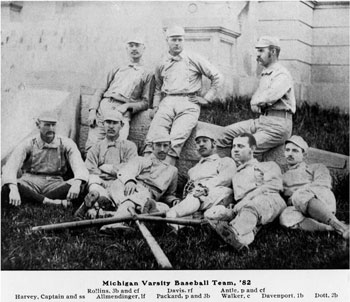In the Archives: Dynamite Baseball Catcher
Editor’s note: Laura Bien’s local history column appears in The Ann Arbor Chronicle usually sometime around last Wednesday of the month. This month’s column draws upon the archives of The Ann Arbor Chronicle’s namesake – a 19th century University of Michigan student newspaper called The Chronicle-Argonaut. In its era, The Chronicle-Argonaut maintained a rivalry with the Michigan Daily – in the form of a “base ball” game. So it’s fitting that Bien’s column this month also highlights University of Michigan baseball from that time period.
He smashed the color barrier in major league baseball. During his lifetime, Congress passed sweeping civil rights legislation. No modern baseball player can wear his team number on a uniform. And unlike Jackie Robinson, he was a University of Michigan alum.
Moses Fleetwood Walker was born Oct. 7, 1856 in Mount Pleasant, Ohio. His parents may have settled there due to the eastern part of the state’s long association with the Underground Railroad.
Moses, or Fleet as he was later called, was the fifth or sixth of seven children born to physicians Moses and Caroline Walker. The 1860 census lists two three-year-olds, Moses and Lizzie. The little girl, possibly Moses’ twin, does not appear in the 1870 census.
Soon after Moses’ birth, the family moved to nearby Steubenville, 40 miles west of Pittsburgh. Their neighbors there worked as bricklayers, dyers, pattern makers, tinners, and laborers. Moses attended an integrated school and at graduation chose Oberlin College, one of the first colleges in the nation to admit black and female students. When Oberlin formed its first baseball team in 1881, Moses joined as a catcher.
It was a tough position to play in that era. The catcher had no body protection or face mask. He didn’t even have a glove, but caught barehanded. In addition, in 1881 the pitcher’s throwing position was not 60 feet and six inches from home plate as it is today, but only 50 feet (and before that 45 feet). Pitchers for a time were even allowed to take a running start. Common catchers’ injuries included broken ribs and fingers, facial injuries, and concussions. [Full Story]




